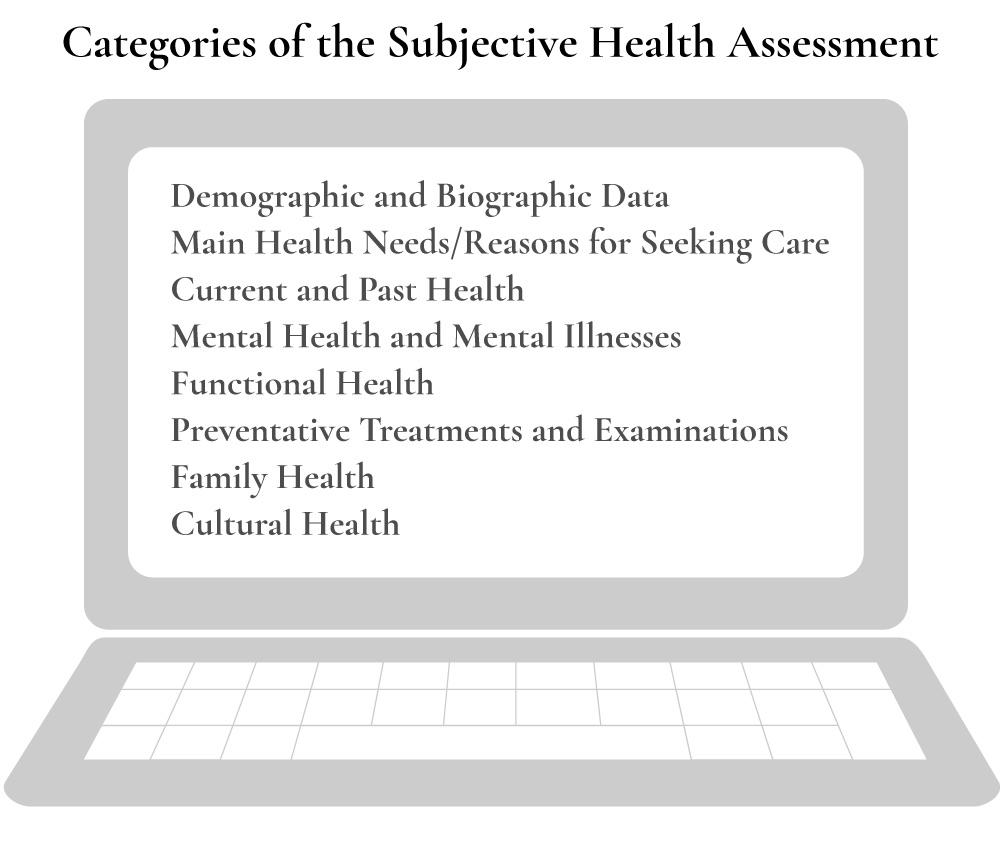Categories and Influencing Factors
Categories
Categories of the complete subjective health assessment (as illustrated in Figure 1.4) vary depending on the framework you follow, but generally include:
- Introductory information: Demographic and biographic data.
- Main health needs (reasons for seeking care).
- Current and past health.
- Mental health and mental illnesses.
- Functional health.
- Preventive treatments and examinations.
- Family health.
- Cultural health.

You begin the assessment with an introduction followed by collecting information about demographic and biographic data and then, main health needs. Afterwards, there is no specific order in which these categories must be assessed. Often it depends on the client’s main health needs or reasons for seeking care. Sometimes it depends on the natural flow of conversation that occurs with the client. Usually, you assess sections that involve sensitive questions as well as cultural health towards the end when you have had the opportunity to develop a level of trust with the client. Remember, when introducing yourself state your full name, designation, and pronouns, and then ask the client what name and pronouns you should use to refer to them. It is important not to use the term “preference” when referring to pronouns and gender as these are not preferences.
In addition to these categories, you may incorporate subjective questions specific to each of the body’s systems; this phase is called a Review of the Systems. These questions give you insight into each body system (e.g., skin, eyes, cardiovascular, musculoskeletal). Depending on the client’s response and the reporting of cues that prompt your concern, you may probe further with more specific questions. In other readings, you will learn about subjective questions related to each body system.
Clinical Tip
Always ask one question at a time.
Influencing Factors
Influencing factors constitute common situational issues that can arise during a subjective data assessment. Always consider factors that may influence how you ask questions and the validity and reliability of the subjective data collected. These situational factors can be difficult to both assess and address in certain cases (see Table 1.2).
| Factors | Strategies |
|
Clients may be hyperaware of the situation and wonder why you are asking certain questions.
|
|
|
Clients may downplay or exaggerate what they tell you.
|
|
|
Clients may withhold information because they fear sharing information, feel judged by sharing certain information, and/or have a condition that is often stigmatized.
|
|
|
Clients may not be fully conscious or oriented due to a physical injury, a mental health condition, a traumatic event, or substance use. |
Note: With a client who is under the influence of a substance, it is important to avoid prejudice, remain nonjudgmental, treat them with respect, speak slowly and clearly with simple language, provide a safe environment for them, and continue to monitor while observing changes in behaviour and level of consciousness. |
|
Clients may function at a developmental age (as opposed to actual age). Developmental age is the age that a client functions at on a cognitive, physical, emotional, and social level. You need to consider this factor with all ages across the lifespan.
|
|
Table 1.2: Influencing factors and strategies
Points of Consideration
It is important to document who provides the subjective data. Usually, subjective data is provided by the client (primary source), but in some situations it may be collected from the client’s chart, family members, friends, co-workers, care partners, or interpreters
(secondary sources). In certain cases, the client may be unable to speak or share information, or may speak a different language than you, or be unconscious. Additionally, a care partner (such as a family member) may need to provide subjective data for a newborn or a client with developmental, cognitive, or mental health states that prohibit them from speaking.
Test Yourself
Questions specific to each body system.
Symptoms or signs that signal a potential concern that may need to be investigated further (e.g., headaches)
Data provided by the client.
Data provided by someone other than the client.

